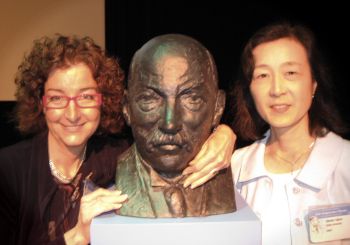
Laura Greene (left) and Setsuko Tajima (right) with the bust of Heike Kamerlingh Onnes, who liquefied helium 100 years ago last month. (Credit: Dirk van der Marel)
By Matin Durrani
With term over and no students to teach, the summer has always been peak season for scientific conferences. There’s no shortage of interesting meetings to pick from, but I am representing Physics World at the 25th International Conference on Low-Temperature Physics in Amsterdam.
One reason for attending is that the Dutch capital is a short flight from Physics World’s base in Bristol in the UK — so I am either saving money or minimizing my carbon footprint, depending on how you look at things.
Another reason is that IOP Publishing, which publishes Physics World, has had a big presence at the meeting as the proceedings are to appear in our very own Journal of Physics Conference Series.
More importantly, though, there’s just loads going on at this three-yearly bash — from fundamental studies into liquid helium to a host of talks on ultracold atom optics. But one of the highlights so far has been a special “romp” session last Friday on a new class of iron-based superconductors, known rather cumbersomely as the “oxy-pnictides”.
Scientists in Japan first reported these materials in February this year, when they found that they could conduct electricity without resistance when cooled to below 26 K.
Since then there has been a huge surge of interest in these superconductors both on the experimental and theoretical fronts. Researchers have been feverishly tinkering with the materials’ structure, composition and doping levels, with the best materials having superconducting transition temperatures of as high as 55 K. One of the leaders of the field, Hai-Hu Wen from Beijing is writing about them in the next issue of Physics World.
I caught up with Laura Greene from the University of Illinois at Urbana-Champaign and Setsuko Tajima from the University of Osaka, who co-chaired the so-called romp session. Over coffee in the foyer, Greene explained to me that it was organised along similar lines to the now legendary “Woodstock of physics” meeting at the American Physical Society in New York in April 1987. Back then, some 3000 physicists packed into a lecture hall to listen to a series of very brief presentations from researchers into the then-new cuprate superconductors.
The Amsterdam meeting was nowhere near as big, but there were still about 400 physicists in the main auditorium for a session that lasted for over four hours. Some 28 speakers were each allocated five minutes and what stood out, according to both Greene and Tajima, was that all speakers revealed new data in what is a fast-moving field.
You know what normally happens at these meetings: no-one says anything really new in case someone in the audience races back to their lab, reproduces the results and rushes out a paper, scooping the original researcher in the process.
Here there was no fear factor — all the speakers revealed genuinely new, unpublished data. I asked Greene why researchers were so happy to open up. Partly, she said, it’s just because there is so much new work going on. But Greene had another explanation up her sleeve: “It’s a field with a very low jerk density.”
But the question on everyone’s lips — well, mine at least — is why it was called a “romp” session. Turns out the conference organisers, from the University of Leiden, had originally wanted to call it a “rump” session but got cold feet on account of it sounding like someone’s, ahem, posterior.
But the Dutch researchers failed to twig the alternative meaning of romp, which Greene’s teenage children of course sniggered at immediately. Once the Leiden physicists were told, they wanted to change the name back again, but Greene said that would only make a bad situation worse. So romp it was to be.
I’ll have more to report on later in the week.



